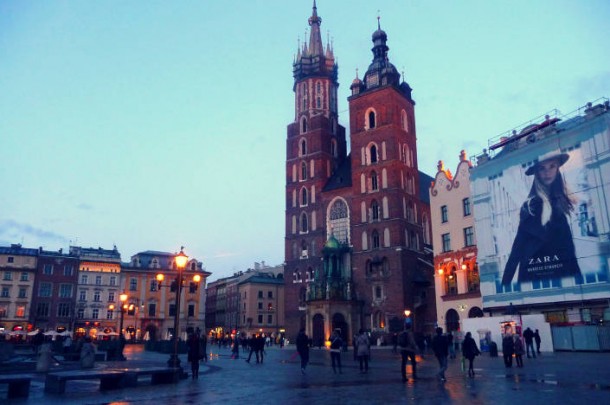KRAKOW, POLAND. You can’t say you know Poland without visiting one of the main historical cities in the country, considered one of Europe’s most beautiful and historic cities by UNESCO. That’s the case of Krakow, in the south, just three hours from Warsaw by train and the main stage of the Holocaust during II World War. Although small, Krakow was once the capital of Poland until the XVI century and has been considered one of the leading centres of cultural and academic life in Poland.
As a city where culture it’s the Queen, Krakow attracts thousands of students, Polish and foreigners, the entire year and even during winter the city gets busy. You can find good hotels but it also has some nice and really cheap hostels, where you can meet new people and try the funny pub crawls. For those who are not studying, Krakow is also a place worth seeing not only because of the architectural and cultural difference from Warsaw but also because of the memorials from Nazi and the Jews extermination that keep reminding us this sad part of History.
Auschwitz and Bikernau
Book a trip with your hostel or just go to the tour guides and they’ll take you to the sad remains of the extermination camps, 1h30 from the city center. An interesting journey where you can feel what you only saw in movies and be prepared to see the hard conditions, some of the luggage, the shoes or even the hair of the prisoners. A true memorial to all who lost their lives innocently.

The entrance of the extermination camp in Auschwitz, with the sentence “Work makes you free” on top
Wawel Castle
Krakow was not only stage of the atrocities by the Nazi but also a historical place since Kings and Queens and Tartar hordes’ time. This fairy-tale castle looking at the river is a symbol of national pride since XIV century and a place of many treasures. The garden, the Crown Treasury and the Cathedral are worth a visit, offering a comforting view to the river and other side of the city, especially on sunny days.
Salt Mine
You’ll be surprised by the depth and size of this salt mine – where concerts are given! -, at Wieliczka, and be prepared to step 380 wooden stairs. The ticket is valid for the Tourist Route and the Underground Museum, with a total of 3 hours visiting the underground. There, you’ll find astonishing sculptures made by the miners through the years, enormous chandeliers and a chapel from the XVII century, as a highlight of the journey.

The chapel inside the Salt Mine, with chandeliers made of transparent salt
One thing I can’t complain in Poland is the wide choice of restaurants or bars. I’m used to the small size of places, so typical from Warsaw, and now from Krakow. Although sometimes it’s difficult when it’s crowded, it’s a part of the beauty of the city. A weekend is not enough to try all options but you can start by Camelot for breakfast – all day long -, where you’ll be welcomed with its rustic and bohemian charm and variety in the menu.
If you want something more consistent to give you strength, Pod Wawelem – literally meaning “near the castle” – and U Babcia Maliny are the choices and you won’t get more traditional than this, with tons of delicious meat, traditional dishes like “bigos” and the most important, vodka. To finish the night, try Nowa Prowincja, where you’ll feel at home, or for a more cosy and different style – reminding the 70’s – the Spokoj bar, if you can find the entrance.

